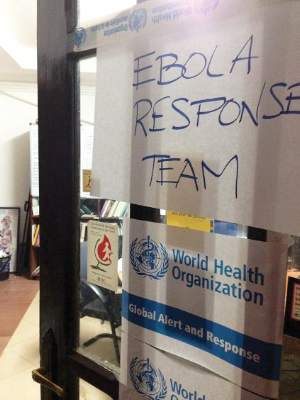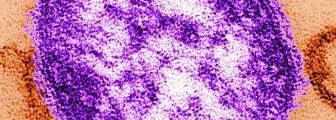The struggle to defeat Ebola virus disease continues globally, although it may not always make the headlines. To catch up on what you may have missed, here are some notable news items and journal articles published over the past few weeks that are worth a second look.
The potential exists for the emergence of a new form of Ebola virus, according to research published in Scientific Reports . Only a few mutations in one Ebola virus protein, VP24, may be necessary to render the Reston virus, which currently circulates in pigs, into a virus that can cause human disease and to develop into a novel health threat.
According to a report in MMWR, a single, traditional funeral of a prominent pharmacist was associated with a sharp increase in the number of reported Ebola cases in a previously low-incidence district of Sierra Leone. This affirms that vigilant Ebola surveillance and rapid response are essential, and immediate, safe burials by trained teams are critical to interrupting transmission and controlling Ebola.
Rhesus monkeys were completely protected from Ebola virus when treated three days after infection with a compound that blocks the virus’s ability to replicate . Investigators say these encouraging preclinical results suggest the compound, known as GS-5734, should be further developed as a potential treatment.
Social media tools could be used effectively as surveillance response mechanisms for improving the detection of, preparedness, and response to Ebola virus outbreaks , as a complement to traditional, filed, work-based surveillance approach, according to a study. The research, published in Epidemiology & Infection, suggested that the public health response to an Ebola outbreak could be more proactive rather than reactive by the use of social media to fill in the “missing gaps” in news reports and outreach.
CDC investigators, in a perspectives article in Emerging Infectious Diseases, offered suggestions to improve governmental and health care organizational response to future Ebola virus outbreaks . Ideal responses should include accurately identifying the viral reservoir, improving in-country detection and response capacity, conducting survivor studies and supporting survivors, engaging in culturally appropriate public education and risk communication, building productive interagency relationships, and continuing support for basic research.
During the Ebola epidemic in Guinea, calls to prefecture health departments were more sensitive for Ebola virus disease case detection than those to a national call center , according to a study in MMWR. The authors said low sensitivity for Ebola case detection limits the utility of a national call center as a surveillance system.
A report in Science Translational Medicine suggests that the antibody cocktail used in Ebola virus–infected patients can be further simplified to only two antibodies and that these antibodies can be produced in engineered Chinese hamster ovary cells. Such a cocktail protected nonhuman primates against the virus responsible for the 2014-2015 outbreak up to 3 days after exposure, and combining these antibodies with those specific for other strains may lead to a broad Ebola virus therapy.
Rapid testing for the Zika virus is a critical need in the recent Ebola-affected countries of Liberia, Sierra Leone, and Guinea , said Dr. Daniel R. Lucey, adjunct professor of medicine at Georgetown University, Washington, because of the recent Zika outbreak on nearby Cape Verde and the similarity in symptoms between Zika and early Ebola.
A meta-analysis of the risk factors for transmission of Ebola or Marburg virus disease found that transmission of any African filovirus is unlikely except through close contact, especially during the most severe stages of acute illness . However, the investigators said more data are needed about the context, intimacy, and timing of contact required to raise the odds of disease transmission, as well as risk factors specific to urban settings.
There is no shortage of lessons learned from the recent Ebola epidemic, including the need for reforms in rapid response capability, research, leadership, and better governance , notes an essay in the International Journal of Epidemiology. But the importance of disease mapping appears to have been overlooked.
A meta-analysis of the Ebola household secondary attack rate (SAR) estimated that 27.1% of Ebola infections are asymptomatic . Transmission was driven by direct contact, with little transmission occurring in its absence (SAR, 0.8%). The greatest risk factor was the provision of nursing care. The findings suggest that surveillance and containment measures should be effective for controlling Ebola.
A study of Ebola virus disease survivors in Sierra Leone found patients experiencing a variety of long-term complications, including ocular problems like uveitis . In fact, EVD survivors were 10 times more likely to develop uveitis post EVD if they presented with red/injected eyes during the acute phase of their illness.
A review essay in Lancet Infectious Diseases assesses what is known regarding the sequelae of Ebola virus disease, including possible delayed virus clearance . The authors discuss some of the key challenges regarding the provision of care to survivors – calling it the “emergency within the emergency” – and implementation of necessary future research.
Researchers at Middle Tennessee State University investigated the potential of basic Susceptible-Exposed-Infectious-Recovered (SEIR) models to describe the 2014 Ebola outbreak in Meliandou, Guinea . They found that density-dependent transmission and mortality-induced behavioral changes shaped the course of the Ebola epidemic in Meliandou, while frequency-dependent transmission, disease-induced emigration, and infection-induced behavioral changes are not consistent with the data from that particular epidemic.
A study in Preventive Medicine proposes an alternative policy for Ebola entry screening at airports in the United States . This alternative policy considers a social contact tracing (SCT) risk level, in addition to the current health risk level used by the CDC.
A study evaluating the performance of the Cepheid GeneXpert Ebola assay on clinical venipuncture whole blood (WB) and buccal swab (BS) specimens found the assay had excellent performance compared to an established RT-PCR benchmark on WB and BS samples in a field laboratory setting . The authors said future studies should evaluate feasibility and performance outside of a biocontainment laboratory setting to facilitate expanded access to testing.
On Twitter @richpizzi





